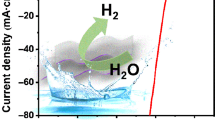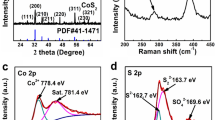Abstract
Though the transition-metal dichalcogenides (TMDs) were proven to have a better performance on the hydrogen evolution reaction (HER), the bulk production of active TMD materials remains a challenging work. This report overcomes those barriers by showing a simple procedure to synthesize TaS2 nanosheets through modifying the arc discharge process. The usage of chloride as the transporting agent reduces the growth period of the formed TaS2 with active edge sites. TaS2 is found to have a uniform thickness (4 nm) with high crystallinity and adopt a 2H polytype (double-layered hexagonal) structure. The as-synthesized TaS2 has superior activity for HER with the potential of 280 mV.
Similar content being viewed by others
References
Novoselov K S, Geim A K, Morozov S V, et al. Electric field effect in atomically thin carbon films. Science, 2004, 306(5696): 666–669
Zhu Y, Murali S, Cai W, et al. Graphene and graphene oxide: synthesis, properties, and applications. Advanced Materials, 2010, 22(35): 3906–3924
Balandin A A. Thermal properties of graphene and nanostructured carbon materials. Nature Materials, 2011, 10(8): 569–581
Meric I, Han M Y, Young A F, et al. Current saturation in zerobandgap, top-gated graphene field-effect transistors. Nature Nanotechnology, 2008, 3(11): 654–659
Zhang H. Ultrathin two-dimensional nanomaterials. ACS Nano, 2015, 9(10): 9451–9469
Zeng Z Y, Tan C L, Huang X, et al. Growth of noble metal nanoparticles on single-layer TiS2 and TaS2 nanosheets for hydrogen evolution reaction. Energy & Environmental Science, 2014, 7(2): 797–803
Wu J J, Liu MJ, Chatterjee K, et al. Exfoliated 2D transition metal disulfides for enhanced electrocatalysis of oxygen evolution reaction in acidic medium. Advanced Materials Interfaces, 2016, 3(9): 1500669
Radisavljevic B, Radenovic A, Brivio J, et al. Single-layer MoS2 transistors. Nature Nanotechnology, 2011, 6(3): 147–150
Raj S I, Xu X W, Yang W, et al. Highly active and reflective MoS2 counter electrode for enhancement of photovoltaic efficiency of dye sensitized solar cells. Electrochimica Acta, 2016, 212: 614–620
Liu C, Kong D, Hsu P C, et al. Rapid water disinfection using vertically aligned MoS2 nanofilms and visible light. Nature Nanotechnology, 2016, 11(12): 1098–1104
Tan C, Zeng Z, Huang X, et al. Liquid-phase epitaxial growth of two-dimensional semiconductor hetero-nanostructures. Angewandte Chemie International Edition in English, 2015, 54(6): 1841–1845
Zhang X, Lai Z, Liu Z, et al. A facile and universal top-down method for preparation of monodisperse transition-metal dichalcogenide nanodots. Angewandte Chemie International Edition in English, 2015, 54(18): 5425–5428
Lee Y H, Zhang X Q, Zhang W, et al. Synthesis of large-area MoS2 atomic layers with chemical vapor deposition. Advanced Materials, 2012, 24(17): 2320–2325
Muratore C, Hu J J, Wang B, et al. Continuous ultra-thin MoS2 films grown by low-temperature physical vapor deposition. Applied Physics Letters, 2014, 104(26): 261604
Etzkorn J, Therese H A, Rocker F, et al. Metal-organic chemical vapor deposition synthesis of hollow inorganic-fullerene-type MoS2 and MoSe2 nanoparticles. Advanced Materials, 2005, 17(19): 2372–2375
Nath M, Rao C N R. New metal disulfide nanotubes. Journal of the American Chemical Society, 2001, 123(20): 4841–4842
Dunnill C W, MacLaren I, Gregory D H. Superconducting tantalum disulfide nanotapes; growth, structure and stoichiometry. Nanoscale, 2010, 2(1): 90–97
Li P, Stender C L, Ringe E, et al. Synthesis of TaS2 nanotubes from Ta2O5 nanotube templates. Small, 2010, 6(10): 1096–1099
Yu Y, Yang F, Lu X F, et al. Gate-tunable phase transitions in thin flakes of 1T-TaS2. Nature Nanotechnology, 2015, 10(3): 270–276
Schuffenhauer C, Parkinson B A, Jin-Phillipp N Y, et al. Synthesis of fullerene-like tantalum disulfide nanoparticles by a gas-phase reaction and laser ablation. Small, 2005, 1(11): 1100–1109
Park K Y, Kim H J, Suh Y J. Preparation of tantalum nanopowders through hydrogen reduction of TaCl5 vapor. Powder Technology, 2007, 172(3): 144–148
Sun G, Liu J, Zhang X, et al. Fabrication of ultralong hybrid microfibers from nanosheets of reduced graphene oxide and transition-metal dichalcogenides and their application as supercapacitors. Angewandte Chemie International Edition, 2014, 53(46): 12576–12580
Wu X C, Tao Y R, Gao Q X. Fabrication of TaS2 nanobelt arrays and their enhanced field-emission. Chemical Communications, 2009, 40(40): 6008–6010
Wu X C, Tao Y R, Gao Q X, et al. Superconducting TaS2–xIy hierarchical nanostructures. Chemical Communications, 2009, 28(28): 4290–4292
Ubaldini A, Jacimovic J, Ubrig N, et al. Chloride-driven chemical vapor transport method for crystal growth of transition metal dichalcogenides. Crystal Growth & Design, 2013, 13(10): 4453–4459
Li P, Stender C L, Ringe E, et al. Synthesis of TaS2 nanotubes from Ta2O5 nanotube templates. Small, 2010, 6(10): 1096–1099
Wu X, Tao Y, Hu Y, et al. Tantalum disulfide nanobelts: preparation, superconductivity and field emission. Nanotechnology, 2005, 17(1): 201–205
Wu X C, Tao Y R, Gao Q X, et al. Superconducting TaS2–xIy hierarchical nanostructures. Chemical Communications, 2009, 28(28): 4290–4292
Wu X C, Tao Y R, Gao Q X. Fabrication of TaS2 nanobelt arrays and their enhanced field-emission. Chemical Communications, 2009, 40(40): 6008–6010
Li P, Stender C L, Ringe E, et al. Synthesis of TaS2 nanotubes from Ta2O5 nanotube templates. Small, 2010, 6(10): 1096–1099
Schuffenhauer C, Parkinson B A, Jin-Phillipp N Y, et al. Synthesis of fullerene-like tantalum disulfide nanoparticles by a gas-phase reaction and laser ablation. Small, 2005, 1(11): 1100–1109
Dunnill C W, MacLaren I, Gregory D H. Superconducting tantalum disulfide nanotapes: growth, structure and stoichiometry. Nanoscale, 2010, 2(1): 90–97
Yu Y, Yang F, Lu X F, et al. Gate-tunable phase transitions in thin flakes of 1T-TaS2. Nature Nanotechnology, 2015, 10(3): 270–276
Li H, Tan Y, Liu P, et al. Atomic-sized pores enhanced electrocatalysis of TaS2 nanosheets for hydrogen evolution. Advanced Materials, 2016, 28(40): 8945–8949
Nguyen T P, Choi S, Jeon J M, et al. Transition metal disulfide nanosheets synthesized by facile sonication method for the hydrogen evolution reaction. The Journal of Physical Chemistry C, 2016, 120(7): 3929–3935
Feng Y, Gong S, Du E, et al. 3R TaS2 surpasses the corresponding 1T and 2H phases for the hydrogen evolution reaction. The Journal of Physical Chemistry C, 2018, 122(4): 2382–2390
Acknowledgements
This work was supported by the National Natural Science Foundation of China (Grant Nos. 21576289 and 21322609), the Science Foundation Research Funds Provided to New Recruitments of China University of Petroleum, Beijing (2462014QZDX01) and the Thousand Talents Program.
Author information
Authors and Affiliations
Corresponding author
Supplementary information
Rights and permissions
About this article
Cite this article
Raj, I., Duan, Y., Kigen, D. et al. Catalytically enhanced thin and uniform TaS2 nanosheets for hydrogen evolution reaction. Front. Mater. Sci. 12, 239–246 (2018). https://doi.org/10.1007/s11706-018-0425-0
Received:
Accepted:
Published:
Issue Date:
DOI: https://doi.org/10.1007/s11706-018-0425-0




